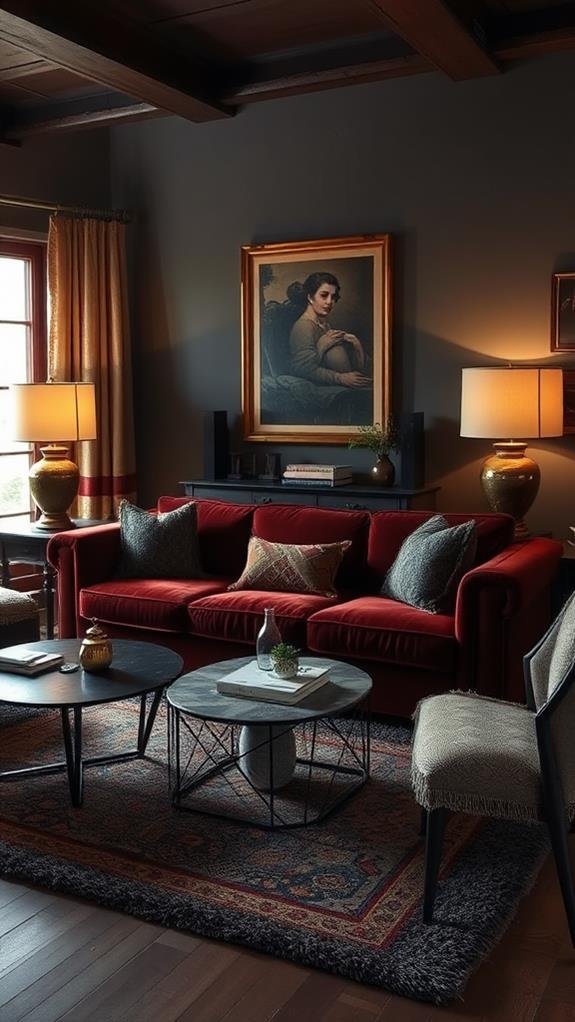7 Secrets for Achieving Moody Interior Design
If you’re looking to create a moody interior design that exudes warmth and sophistication, there are several essential secrets to master. It’s not just about choosing dark colors or heavy fabrics; it’s about creating a space that feels inviting and personal. You’ll need to contemplate your color palette carefully, choose diverse textures, and layer lighting in a thoughtful way to evoke the right atmosphere. But that’s only the beginning—there’s more to investigate that can transform your space into the retreat you’ve always envisioned. What could the next steps be?
Understanding Moody Aesthetics

When you plunge into moody aesthetics, you’ll uncover it’s all about creating an atmosphere that evokes emotion and depth.
This design style incorporates darker tones, rich textures, and unique lighting to stir feelings of comfort and introspection. Think of how shadows can cast a cozy vibe in a room, making it feel inviting and intimate.
Layering elements like plush fabrics, deep woods, and metallic accents can add interest and warmth.
Don’t forget the importance of personal touches, like artwork or meaningful objects, which can deepen the emotional connection you feel in the space.
Ultimately, understanding moody aesthetics lets you transform your environment into a sanctuary that reflects your personal style and resonates with your emotions.
Choosing the Right Color Palette

Color plays an essential role in establishing the mood of your space, so choosing the right palette is key to achieving that rich, emotive atmosphere.
Start by considering the emotions you want to evoke. Darker hues, like deep blues or charcoal, can create a cozy, intimate feel, while muted earth tones bring warmth and comfort. You can also combine a few contrasting colors to add depth and interest.
Remember, the balance between light and dark can make your space feel harmonious. Don’t forget about the finish; matte surfaces absorb light and create softness, while glossy finishes reflect it for a more dynamic vibe.
Ultimately, trust your instincts. Your color choices should reflect your personality and make you feel at home.
Incorporating Textural Elements

To improve your interior design, don’t overlook the power of textural elements. Adding different textures can make a space feel warm and inviting. Think about using soft pillows, plush rugs, or woven throws to create a cozy atmosphere.
Combining materials like leather, wood, and metal can provide visual interest and contrast. You might consider incorporating textured wallpaper or fabric to add depth to your walls.
Even items like ceramics or plants can introduce unique textures. These elements not only elevate the mood but also engage your senses, making the space feel more alive.
Effective Lighting Techniques

Lighting can make or break the mood of any room, so it’s essential to set it up right.
Start by layering your light sources, combining ambient, task, and accent lighting. Ambient light provides overall illumination, while task lighting helps with specific activities, like reading. Use warm light bulbs to create a cozy atmosphere that feels inviting and relaxing.
Don’t forget about dimmers! They let you adjust the brightness to match your mood or activity. Consider adding decorative lamps or fixtures to make the lighting a design feature.
Selecting Statement Furniture

Choosing the right statement furniture can transform a space from ordinary to extraordinary. Start by identifying a standout piece that captures attention, like a bold sofa or an artistic coffee table.
Think about colors, textures, and styles that align with your vision. A deep jewel-tone chaise lounge can bring warmth, while a sleek, minimalist chair adds sophistication.
Don’t shy away from unique shapes, either. An unusually shaped side table can create visual intrigue.
When placing your furniture, balance it with the overall layout of the room. Make sure it’s functional, too, ensuring enough space for movement.
Layering With Decor Accessories

Layering with decor accessories can improve your interior design by adding depth and personality to your space. Start by choosing a color palette that reflects your style.
Then, think about using throw pillows, blankets, and rugs to create texture and comfort. Mixing different materials, like wood, metal, and fabric, can bring even more interest to your room.
Don’t forget to include art pieces or photographs to showcase your personality and memories. A well-placed vase or decorative bowl can serve as focal points, drawing the eye and sparking conversation.
Layering isn’t just about stacking; it’s about arranging accessories in a way that tells a story. This approach transforms your home into a cozy, inviting retreat.
Balancing Spaces and Styles

Creating a cohesive look in your home involves balancing spaces and styles to achieve harmony. Start by choosing a central theme or color scheme that reflects your personality. This theme will guide your selections and create a unifying effect.
For instance, mixing modern and vintage furniture can add character, but make sure their colors and textures complement one another. Create designated areas in each room; use rugs or furniture placement to define different zones.
Shift smoothly between styles by incorporating accessories that tie them together, like artwork or decorative pillows. Don’t forget lighting, as it can greatly influence mood.
Focus on balance, ensuring no single style overwhelms the space, and your home will feel both inviting and thoughtfully designed.
Conclusion
By following these seven secrets, you can easily create a moody interior design that feels cozy and inviting. Start with a rich color palette and add texture through different materials. Don’t forget the importance of lighting to set the mood. Choose standout furniture pieces that reflect your style, and layer in decor accessories for that personal touch. Balancing all these elements will help you transform your space into a welcoming retreat that you’ll love coming home to.


